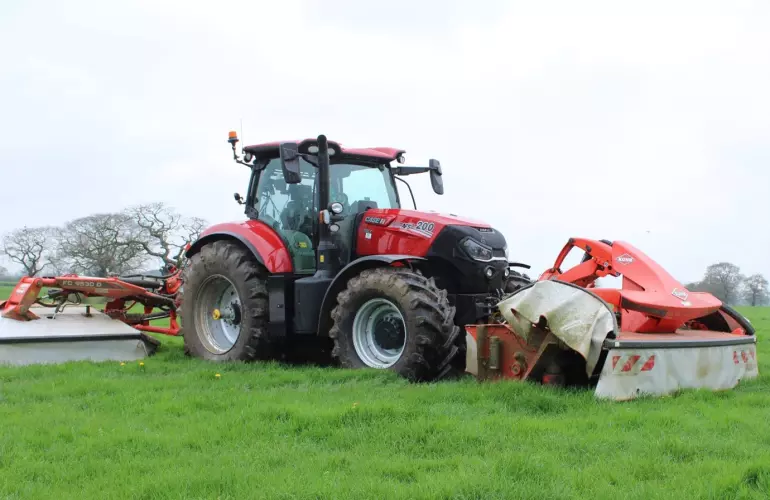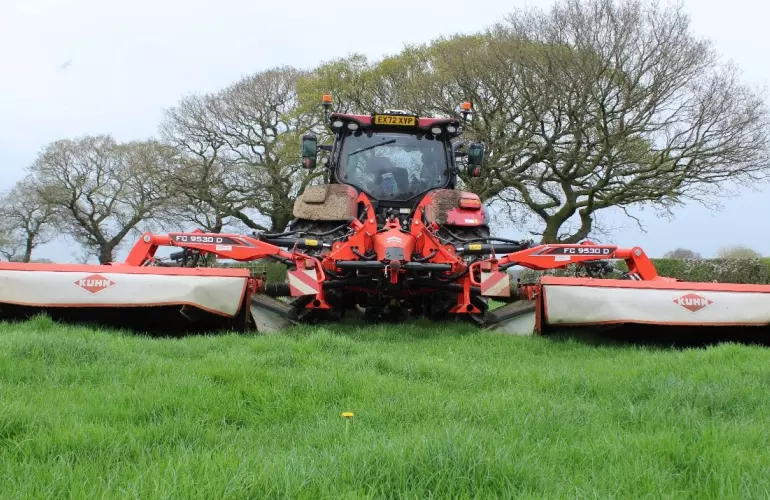Making the cut for forage quality
Farmer and contractor, Nigel Harper has recently invested in a second set of KUHN triple mowers to reinforce the very strong list of machinery he and his team use to cut 18,000 acres of grass, wholecrop and maize in Cheshire per year. With 700 Holstein Friesian cows to feed at two farms, and clients spread over a 10-mile radius from the business’s base in Byley, he has a busy fleet of 10 Case tractors and two Krone forage harvesters.

“We farm 800 acres ourselves with a multi-cut system that incorporates five cuts each season. The grass leys are multipurpose so we can graze or ensile depending on the weather and how the herd is performing. Having the contracting business is a huge help to dairying because we have the machinery needed to maximise milk from forage,” he says.
He is soil testing every two years and utilising the slurry produced at the two farms to his advantage by choosing a multi-cut system. He also suggests that having moved to multi-cut he is ensiling more grass each season which is helping to reduce costs, despite the added man hours needed to harvest it.
“With the contracting business we have invested in the best machines for each task. The KUHN mowers are examples of extremely reliable and easy to maintain pieces of machinery that cover thousands of acres accurately and efficiently. We aim to cut just above the bottom leaf, to speed up regrowth, and the way the mowers follow the ground, even when it is undulating, is second to none,” he explains.

To reduce the time needed to harvest grass for the farm, he collects grass the day after the mowers. He suggests the mowers are so good at conditioning the grass that it wilts faster and is easier to pick up.
“We are very focussed on making the best forage we can for our own herd and for our customers. We want to maximise the nutritional value and the faster we can pick the grass up and ensile it, the more energy we are locking in. Our grass is up to 17.2% protein with 11% ME, and we are achieving a dry matter of 33-34%. The conditioner enables us to get this reliably, and that is pushing up our milk from forage,” he says.
The business has chosen to combine a front mounted FC 3125 DF mower, with the FC 9530 D twin rear mowers to maximise the acreage it can cover. The mowers fold up well to enable access to most fields and, with a cutting width of over 9 metres, covering the ground is made relatively easy. The OPTIDISC cutter bar, the position of the knives, and the FAST-FIT quick-release knife system makes the mowers both accurate and easy to live with.
“Speed is one thing, but we are also focussed on forage quality. We don’t want any impurities being picked up with the grass and this is where the position of the knives on the KUHN mowers makes all the difference. We find the front mower is particularly good at following the contours of the land which we think is down to the linkage. We have to cover a mixture of flat and quite tricky undulating ground, so knowing the mowers can handle this and deliver an even cut is crucial,” he says.
The farm and the business has become far more focussed on data. Using information from soil tests, Mr Harper has been able to reduce he reliance on bought-in fertiliser and maximise the use of home-produced slurry.
The soil is tested every two years and the slurry is tested at both source and during application. This enables the optimum amount of N, P and K to be applied per acre, which is boosting his forage production.
“We have harvest lab and field mapping on the foragers and our forage box. This captures valuable data that we can use to get the most out of the land whilst also ensuring that we put back in what is needed for the next cut. In a multi-cut system I see this level of analysis as essential because if we don’t make five cuts we stand to lose out,” he says.
With drier summers the data gathered has helped him escape potentially dwindling yields. He accepts that the summer of 2022 was particularly hard and making five cuts was a challenge. However, he is certain that a multi-cut approach is providing a significantly higher yield.
“Before we had yield mapping and harvest lab we were overusing fertiliser to make sure we got the cuts we wanted. Since introducing the technology and harnessing the data, we have reduced our bought-in N by between 15-18%,” he says.
The savings are significant for any farm, especially with the price of fertiliser in recent years. His choice of machinery is paying off by offering flexibility and the opportunity to reduce costs by maximising his forage yield. Indeed, any cost saving measures the business and the farm can make are helping to drive margins.
“We want to invest in machinery that will last. The purchase price of some machines has become untenable. We have chosen to rent our harvesters from Wilson Farming rather than buy them. The mowers are supplied by Malpas Tractors at a very reasonable price, and have lasted four years, without fault, which is why we have bought another set to use this season,” he says.
In his shed he only keeps wearing parts for his KUHN machines, which include an AXIS fertiliser spreader, two power harrows, a 6-furrow plough, combination drill and the two sets of triple mowers.

“Downtime is any farms worst nightmare and that is why we have chosen the best kit for the work. We have important relationships with local dealers, including Pontesbury Tractors and J K Ashbrook for the Case fleet and John Bownes for the Krone machines. Thankfully our choices, and these relationships, have held up well to help us deliver for the cows and our customers,” he says.
With a busy season ahead he is always looking to make incremental improvements to both forage quality and quality, whilst keeping a close eye on overheads. The cost of harvesting grass is going up and so he has reacted by investing in technology and machinery to give him the advantage over what the weather and rising costs will throw at him.
“We have to be able to do the tonnage to make best use of the machinery and the time it takes to ensile the five cuts. If we do this efficiently, and use the data we have collected to optimise inputs, we can make top quality forage that will increase our milk yields, and help our customers,” he concludes.
